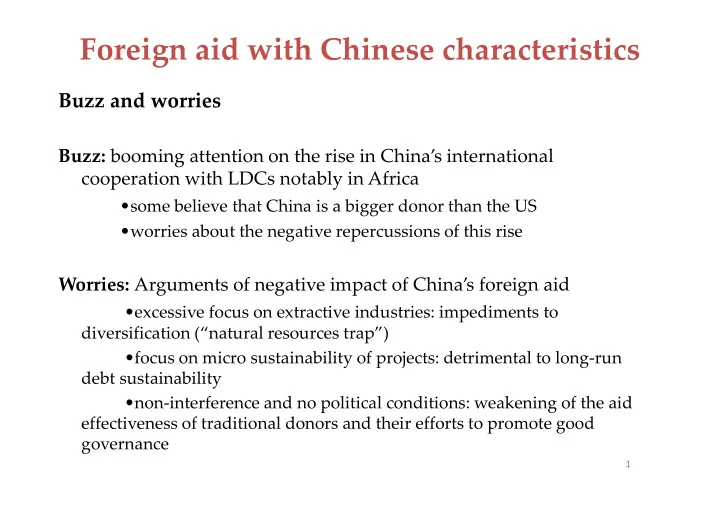

Foreign aid with Chinese characteristics Buzz and worries Buzz: booming attention on the rise in China’s international cooperation with LDCs notably in Africa •some believe that China is a bigger donor than the US •worries about the negative repercussions of this rise Worries: Arguments of negative impact of China’s foreign aid •excessive focus on extractive industries: impediments to diversification (“natural resources trap”) •focus on micro sustainability of projects: detrimental to long-run debt sustainability •non-interference and no political conditions: weakening of the aid effectiveness of traditional donors and their efforts to promote good governance 1
Origin of misconceptions Shortage of data Even in the much awaited white paper on China's foreign aid issued by China's Information Office of the State Council on April 21, 2011. •no yearly figure •no breakdown by country Comparability issue China’s aid definition differs from the DAC’s ODA definition -concessional loans only include the interest rate subsidy by the China’s Ministry of Finance but not the loan’s face value. Misconception that Chinese international cooperation is largely based on “concessional loans” (hence ODA) while most of China Eximbank’s lending instruments do not qualify as foreign aid Data are for international cooperation : much broader scope than aid as includes engineering contracts. 2
Assessing the size of China’s aid White paper on China's foreign aid (State Council) on April 21, 2011. •Total foreign aid from 1950s to 2009 of US$38 billion •It came in three forms: Grants: US$16 bn (not including debt relief) MOFCOM Interest-free loans: US$11 bn (some have been cancelled) Concessional loans US$11 from EXIMbank Tentative estimates for year 2008 (Brautigam, 2011) China’s aid : US$ 3.1 bn of which Africa received 46% (US$ 1.4 bn) as a comparison US aid is US$ 29.7 bn with US$ 8 bn going to Africa 3
Source: white paper on China's foreign aid issued by China's Information Office of the State Council on April 21, 2011. (Xinhua/China's Information Office of the State Council)
Source: white paper on China's foreign aid issued by China's Information Office of the State Council on April 21, 2011. (Xinhua/China's Information Office of the State Council)
Assessing the size of China’s aid China is a mid-sized donor in Africa But Chinese aid to Africa is growing fast, increasing on average by 30% yearly since 2004.
Characteristics of China’s aid White paper on China's foreign aid (State Council) on April 21, 2011 declares that Chinese aid is a “model with its own characteristics” • `mutual benefit’ and `win – win’ outcome. -The gift of aid is explained as benefiting both governments -China dismisses the idea of `charity’ stressing that of `friendship’ • no imposition of political conditions : recipient-led assistance Concretely: •Focus on countries with long-established relationships • Emphasis on infrastructure and production (neglected by traditional donors) • Focus on `complete (turnkey) projects ’: 40% of China’s foreign aid -simpler and do not overstretch the weak capacity of the recipient 7
Source: white paper on China's foreign aid issued by China's Information Office of the State Council on April 21, 2011. (Xinhua/China's Information Office of the State Council)
China’s aid as complementary to traditional aid • Geographical and sector focus -small and poor countries : little correlation of geographical distribution with that of DAC (Berthélemy, 2011) -disregarded sectors: agriculture, production and infrastructure -financing of projects demanded by the partner not financed by other donors (Bui Dam in Ghana). Emphasis on local ownership: `self-esteem’ project like government office building, sports stadium, conference centers. • Different approach to common problem of avoiding local embezzlement and corruption -most Chinese aid is in kind or tied -no cash transfer to governments (no budget support, no adjustment or policy loans) -aid is disbursed directly to Chinese companies who do the projects.
China’s international cooperation as complementary to traditional aid • No evidence of antagonism of China’s aid with traditional donors’ development policy -Low costs of Chinese projects limit the case of competition-distortive tied aid. -No negative effect on diversification of exports (Berthélemy, 2011) -No measured detrimental effect on debt sustainability •T he lion’s share of China’s officially supported finance is not actually ODA. Aid is part of a package. -China’s cooperation is mostly made of export credits and non-concessional state loans -Low finance cost of EXIM bank allows relatively cheap loans but not ODA. `Angola model’ : resource-backed loans offered by EXIM bank. China’s cooperation may be developmental, but it is not primarily based on official development aid.
Distinct but converging… China is not attempting to overtly challenge the traditional aid agenda -increased desire to be regarded as important and responsible member of the international community but no clear desire to formulate an articulated model (the so called `Beijing consensus’) -rather embarked in increasing acceptance of some norms and practices * Priorities such as energy/climate change and food security: Environmental impact assessments are required for obtaining Chinese banks financing * Articulation of China’s international cooperation in foreign aid -promote assistance to multilateral institutions -expansion `under the framework of South-South cooperation’ China’s position is consistent with shift towards -`development effectiveness’ instead of more specific `aid effectiveness’ -partnership instead of donor-recipient links
Recommend
More recommend